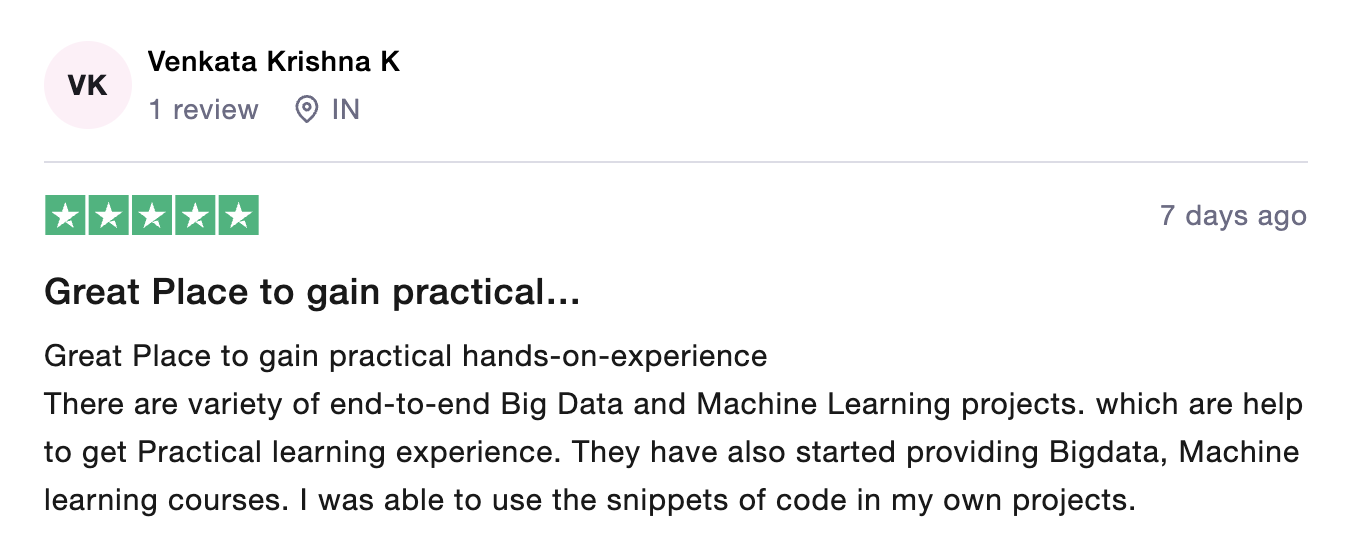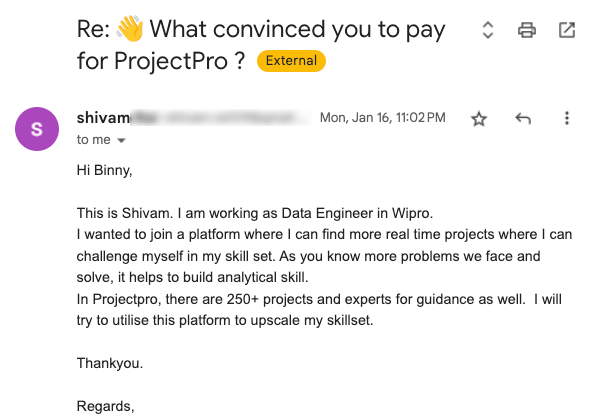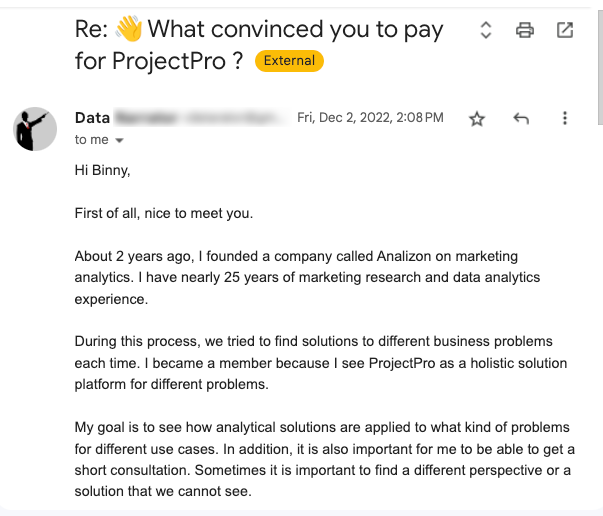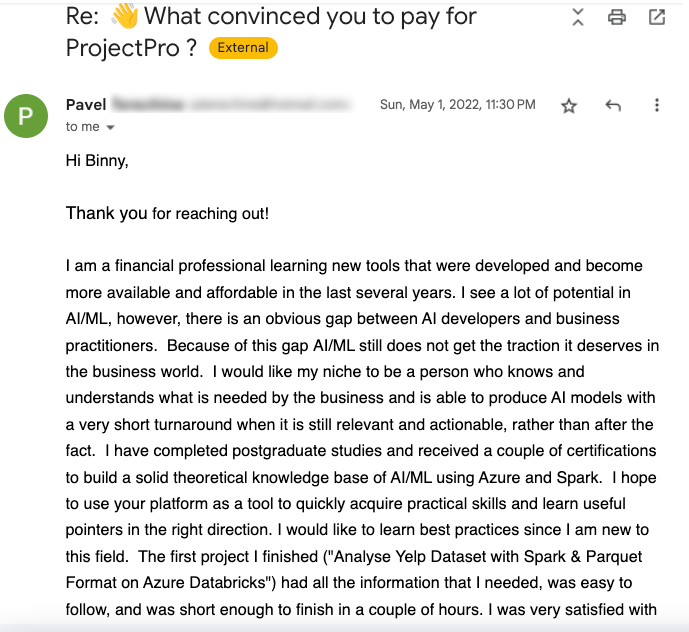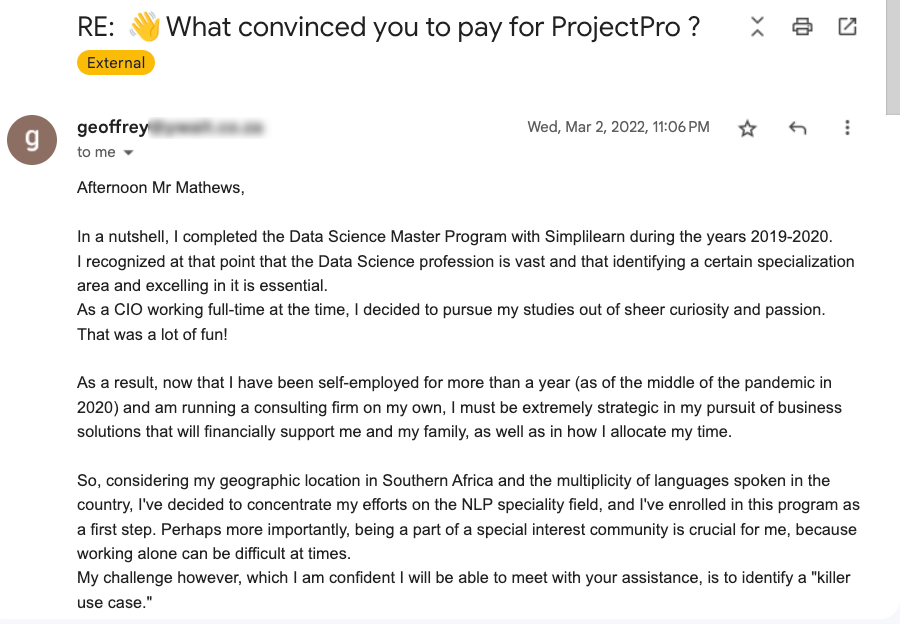
Senior Data Platform Engineer, GoodRx

Data Science, Yelp

Senior Data Engineer, National Bank of Belgium

Global Data Community Lead | Lead Data Scientist, Thoughtworks
Use the Adult Income dataset to predict whether income exceeds 50K yr based oncensus data.
Get started today
Request for free demo with us.
Schedule 60-minute live interactive 1-to-1 video sessions with experts.
Unlimited number of sessions with no extra charges. Yes, unlimited!
Give us 72 hours prior notice with a problem statement so we can match you to the right expert.
Schedule recurring sessions, once a week or bi-weekly, or monthly.
If you find a favorite expert, schedule all future sessions with them.
Source: ![]()
Source: ![]()
Source: ![]()
Source: ![]()
Source: ![]()
Source: ![]()
Source: ![]()
Source: ![]()
Source: ![]()
Source: ![]()
Source: ![]()
Source: ![]()
Source: ![]()
250+ end-to-end project solutions
Each project solves a real business problem from start to finish. These projects cover the domains of Data Science, Machine Learning, Data Engineering, Big Data and Cloud.
15 new projects added every month
New projects every month to help you stay updated in the latest tools and tactics.
500,000 lines of code
Each project comes with verified and tested solutions including code, queries, configuration files, and scripts. Download and reuse them.
600+ hours of videos
Each project solves a real business problem from start to finish. These projects cover the domains of Data Science, Machine Learning, Data Engineering, Big Data and Cloud.
Cloud Lab Workspace
New projects every month to help you stay updated in the latest tools and tactics.
Unlimited 1:1 sessions
Each project comes with verified and tested solutions including code, queries, configuration files, and scripts. Download and reuse them.
Technical Support
Chat with our technical experts to solve any issues you face while building your projects.
7 Days risk-free trial
We offer an unconditional 7-day money-back guarantee. Use the product for 7 days and if you don't like it we will make a 100% full refund. No terms or conditions.
Payment Options
0% interest monthly payment schemes available for all countries.
A census is the process of gathering, compiling, and distributing demographic, economic, and social data relevant to all citizens of a nation or geographically defined area of a country at a given period. Some countries often include a housing census in a census count. It is a method for gathering, compiling, and distributing data about buildings, houses, and amenities like sewage systems, restrooms, electricity, etc.
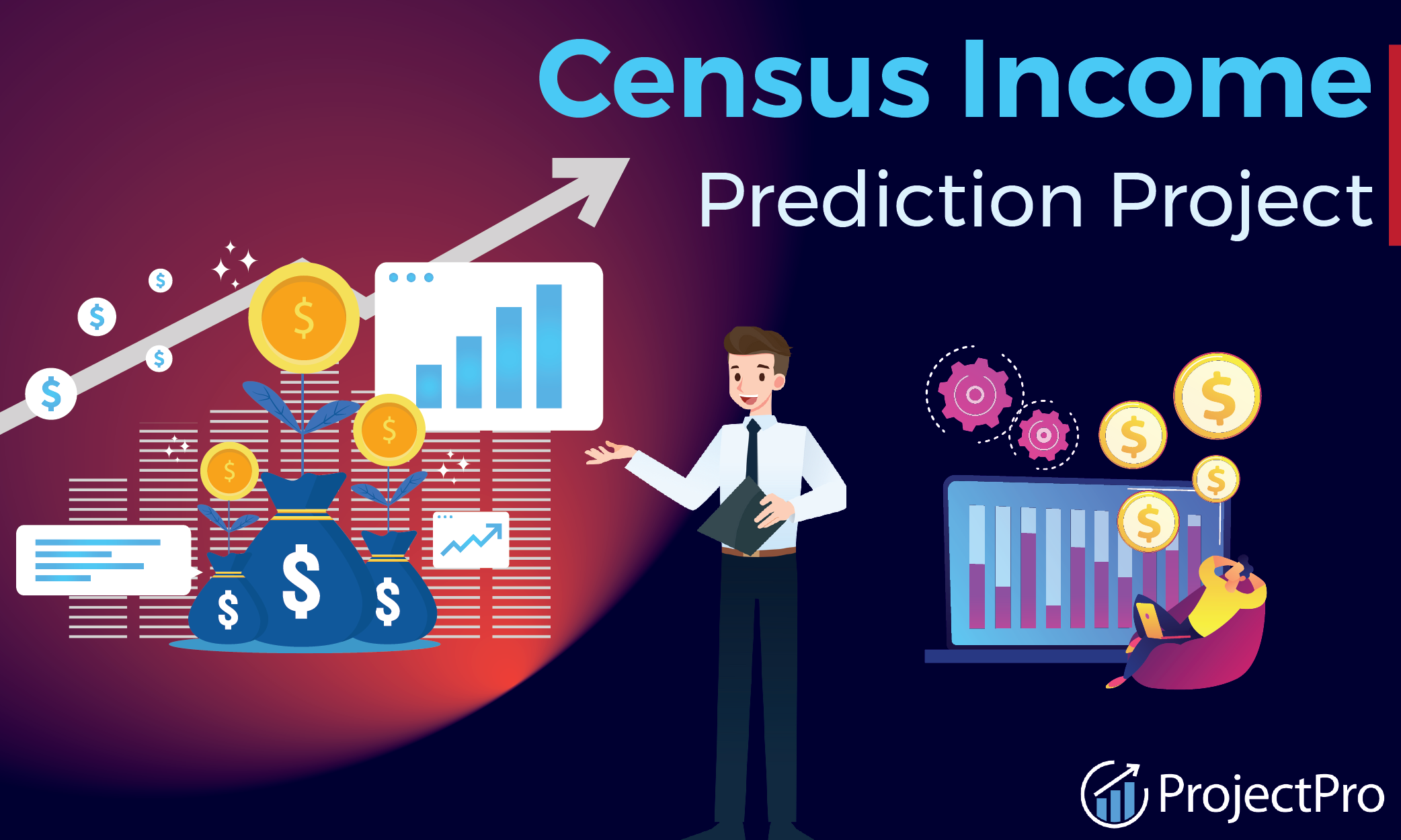
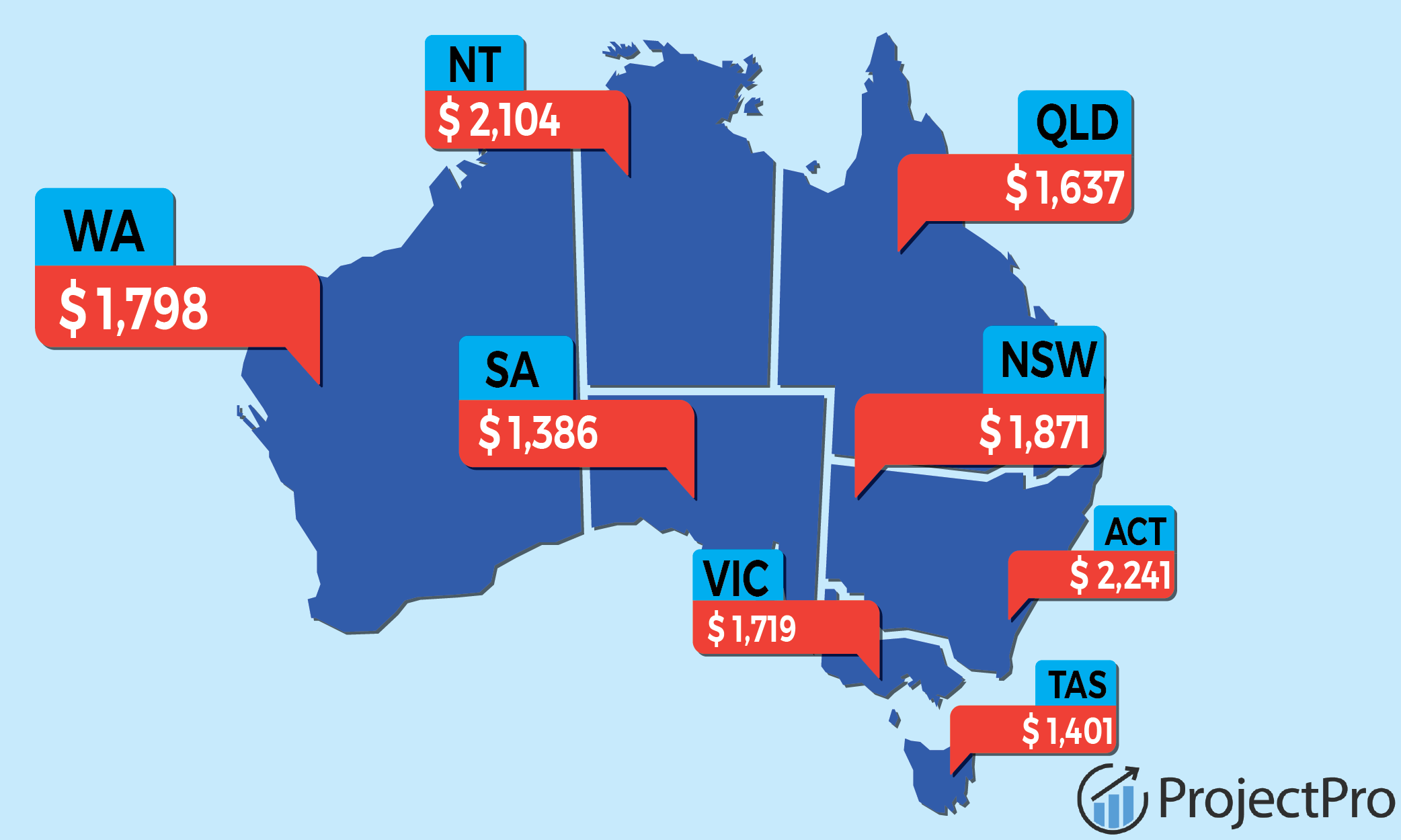
Adult Census Income Prediction is the task of predicting an individual's income level based on their demographic and socioeconomic characteristics. This is typically done using machine learning algorithms trained on large census income data sets. It involves developing ML models that can accurately predict an individual's income level, which can be useful for various applications such as targeted marketing, credit risk assessment, and public policy analysis.

The census income dataset is highly significant as it provides valuable information on economic trends and income distribution. Several businesses, government agencies, and non-profit organizations use this data to assess risk and develop targeted marketing strategies. The census income dataset is valuable for analyzing income inequality and developing policies for boosting economic growth and minimizing poverty.
Below are a few significant use cases of the census income data set-
Healthcare Industry- Healthcare providers can use the Census Income Dataset to identify areas with high poverty levels and develop targeted interventions to improve access to healthcare for low-income individuals.
Real Estate Industry- Real estate companies can use the Census Income Dataset to identify areas with high-income households and develop targeted marketing strategies for luxury homes and other high-end properties.
Education Industry- Educational institutions can use the Census Income Dataset to identify areas with high poverty levels and develop programs to address educational disparities and improve access to quality education.
Non-Profit Industry- Non-profit organizations can use the Census Income Dataset to identify areas with high poverty levels and develop programs to assist and support low-income individuals and families.
Retail Industry- Retailers can use the Census Income Dataset to identify areas with high-income households and develop targeted marketing campaigns for high-end products and luxury brands.
Let us look at a few real-world applications of the census income dataset-
JPMorgan Chase uses the Census Income Dataset to assess credit risk and determine customer loan eligibility. They use this data to create more accurate risk models and make informed lending decisions.
Amazon uses the Census Income Dataset to target advertising campaigns and develop product pricing strategies. They leverage this data to identify customers in different income brackets and customize their marketing and pricing strategies accordingly.
The US Department- Housing and Urban Development uses the Census Income Dataset to analyze income inequality and develop policies to address poverty and promote economic growth. They employ this data to identify areas of the country with high poverty levels and develop targeted policy interventions to address these issues.
Allstate Insurance uses the Census Income Dataset to determine insurance rates and assess customer risk. They use this data to develop more accurate risk models and set insurance rates that reflect the actual risk faced by their customers.
Nielsen Holdings uses the Census Income Dataset to segment customers and develop targeted marketing campaigns based on income level and other demographic factors. They leverage this data to help clients develop more effective marketing strategies tailored to specific customer segments.
In this census income dataset project using Python, we will use a standard imbalanced machine learning dataset called the “Adult Income” or simply the “adult” dataset to perform the necessary prediction task.
The Census-Income (KDD) Dataset is credited to Ronny Kohavi and Barry Becker and was drawn from the 1994 United States Census Bureau data (UCI Machine Learning repository) and involves using personal details such as education level to predict whether an individual will earn more or less than $50,000 per year.
The census income dataset (CSV) provides 14 input variables with a data distribution including categorical variables, ordinal, and numerical data types. The complete list of variables is as follows:
Age.
Workclass.
Final Weight.
Education.
Education Number of Years.
Marital-status.
Occupation.
Relationship.
Race.
Sex.
Capital-gain.
Capital-loss.
Hours-per-week.
Native-country.
The dataset contains missing values with a question mark character (?).
There are a total of 48,842 rows of data, and 3,620 with missing values, leaving 45,222 complete rows.
There are two class values, ‘>50K‘ and ‘<=50K‘, meaning it is a binary classification task. The classes are imbalanced, with a skew toward the ‘<=50K‘ class label.
‘>50K’: majority class, approximately 25%.
‘<=50K’: minority class, approximately 75%.
Census Income Data Source
https://archive.ics.uci.edu/ml/datasets/Adult
This data science project uses the following tools/libraries-
Python
Scikit-learn (machine learning library)
h2o.ai
This unique census income dataset project involves using the Census Salary Data and machine learning algorithms to classify income between >$50K and <=$50K. The income prediction model in this data science project mainly uses machine learning algorithms to help you understand the real estate demands and the demands for basic amenities according to one’s salary range.
This census income prediction machine learning project involves various steps for income prediction using the Census-Income dataset -
A good grasp of the dataset's structure, variables, and meanings provides a solid foundation for analysis and modeling in any data science project.
Obtain the Census-Income dataset and load it into your programming environment.
Explore the dataset's structure, including the number of rows and columns, data types, and missing values.
Identify the meaning and relevance of each variable in the census income dataset, as it is important for feature engineering and model building.
Here is an example of the variables and their meanings in the Census-Income dataset:
Age: Age of the individual.
Workclass: The type of work the individual is engaged in (e.g., private, self-employed, government).
Final Weight: A weight assigned to each observation for survey analysis purposes.
Education: The highest level of education completed by the individual.
Education Number of Years: The number of years of education completed.
Marital-status: The marital status of the individual.
Occupation: The occupation of the individual.
Relationship: The relationship of the individual to the household.
Race: The race of the individual.
Sex: The gender of the individual.
Capital-gain: Capital gains earned by the individual.
Capital-loss: Capital losses incurred by the individual.
Hours-per-week: The number of hours worked per week.
Native-country: The country of origin of the individual.
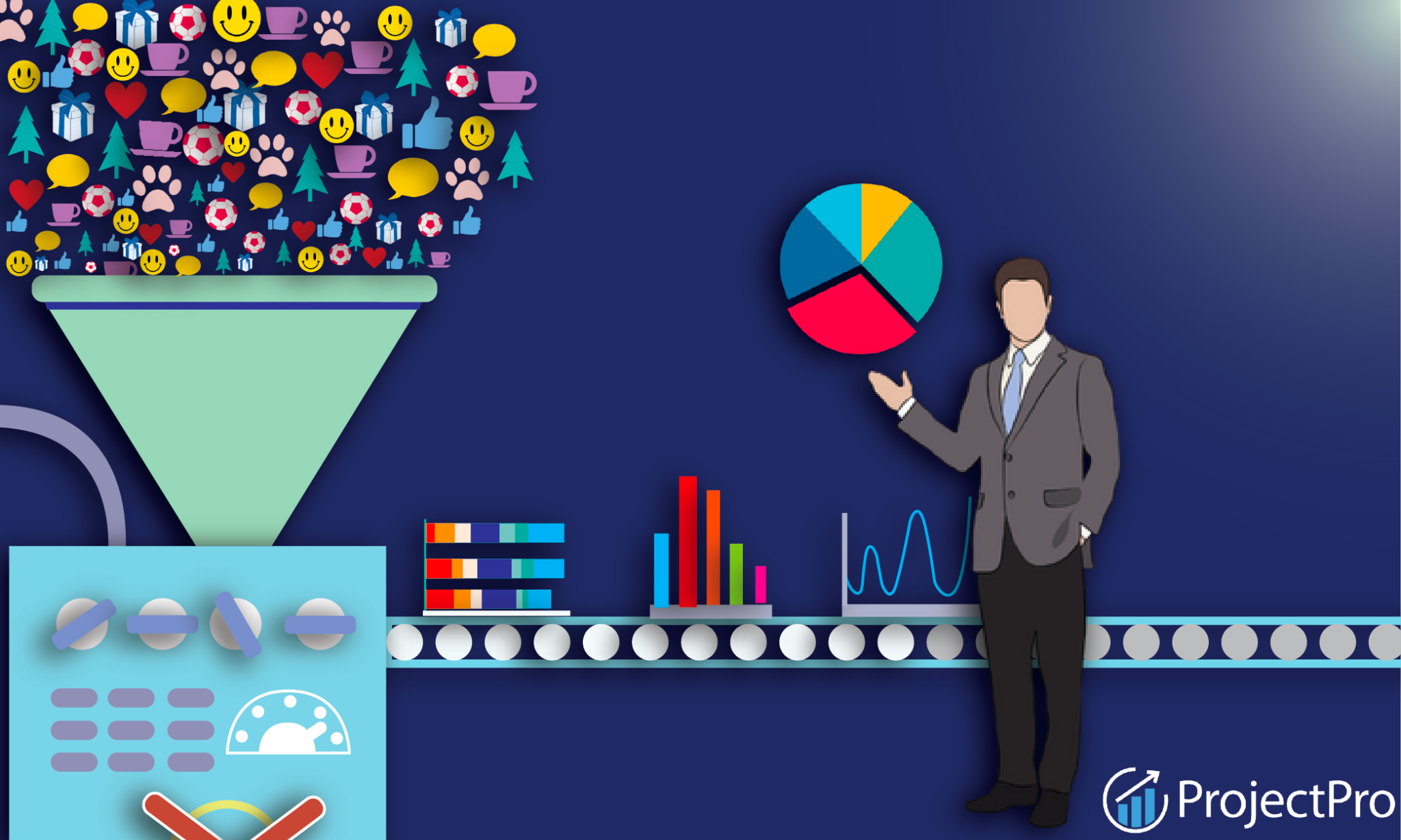
Handle Missing Values: Identify the variables with missing values and decide on an appropriate strategy to handle them (e.g., imputation, removal). In this data science project, we will learn to decide on an appropriate strategy to handle missing values. Missing values are represented as question marks (‘?’), and we replace them with NaN in this data science project. One option is to impute missing values with appropriate values based on the variable type and distribution.
Convert Categorical Variables: If any categorical variables are represented as text, convert them into numerical representations (e.g., one-hot encoding, label encoding) suitable for modeling. In the Census-Income dataset, variables like 'Workclass', 'Education', 'Marital-status', 'Occupation', 'Relationship', 'Race', 'Sex', and 'Native-country' are categorical. Convert categorical variables to numerical representations suitable for modeling.
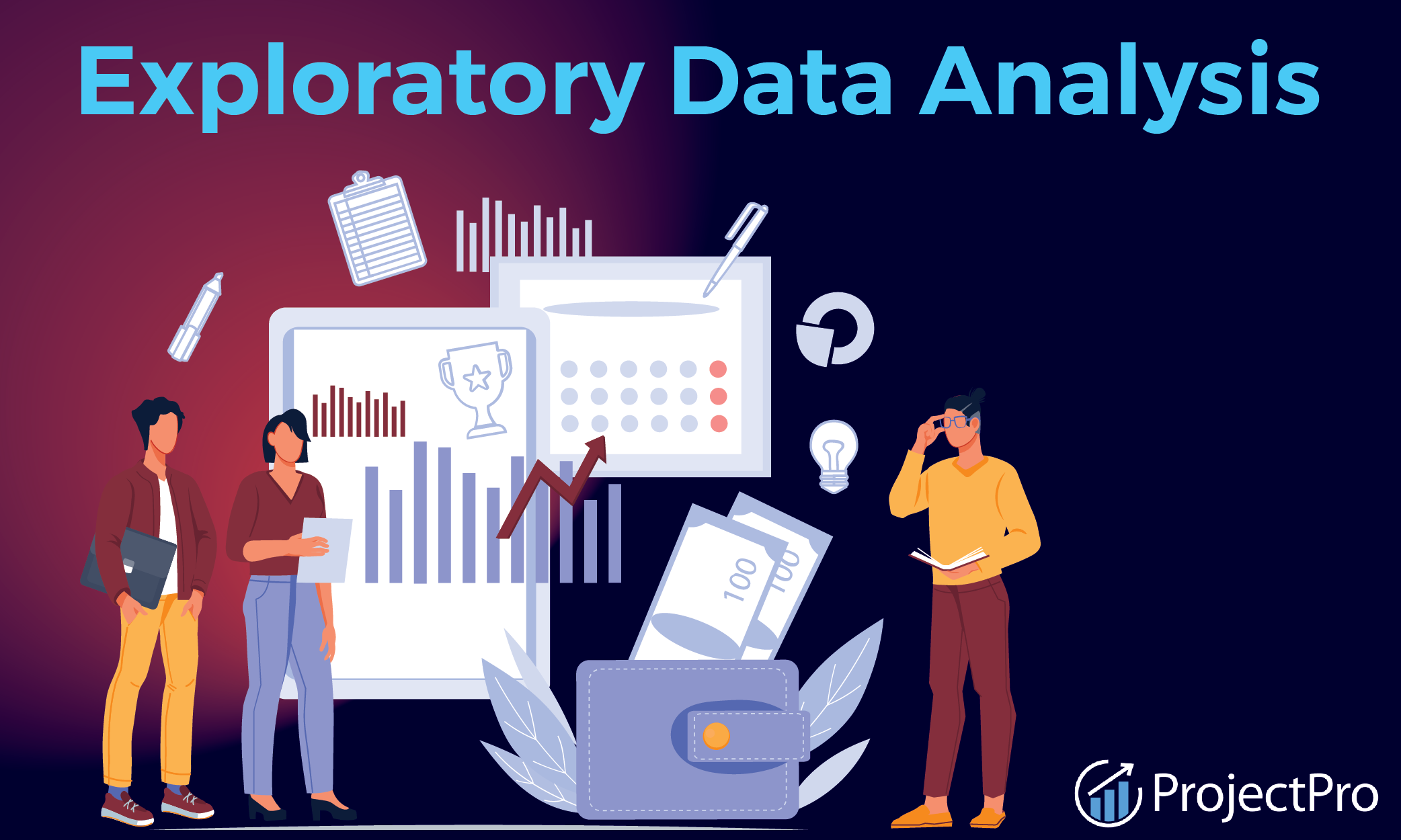
Data scientists utilize exploratory data analysis (EDA) to study and investigate data sets and highlight their key properties, typically using data visualization techniques. It can help in error detection, as well as a better understanding of data patterns, the detection of outliers or unusual events, and the discovery of interesting relationships between variables.
This income prediction project entails performing EDA on the census income dataset. The dataset is visualized using histograms for various categories such as Age range, Education range, etc. Also, descriptive analysis is done to treat the missing values problem.
Perform descriptive statistics and visualizations to gain insights into the dataset. Descriptive statistics provide summary information about the dataset, such as mean, standard deviation, minimum, maximum, and quartiles. Visualizations help in understanding the distribution and patterns in the data.
Analyze the distribution of the target variable ('>50K' and '<=50K') and check for class imbalance. It's important to understand the distribution of the target variable ('>50K' and '<=50K') and check if there is a class imbalance issue because it can affect the performance of machine learning models, which may be biased towards the majority class.
Explore relationships between the features and the target variable to understand their predictive power and potential correlations. It helps determine if certain features strongly influence the income level, allowing you to identify important variables for building predictive machine learning models.
An important point to remember here is that EDA is an iterative process in any data science project, and you can explore various combinations of visualizations and statistical analysis techniques to gain a deeper understanding of the census income dataset when working on this project.
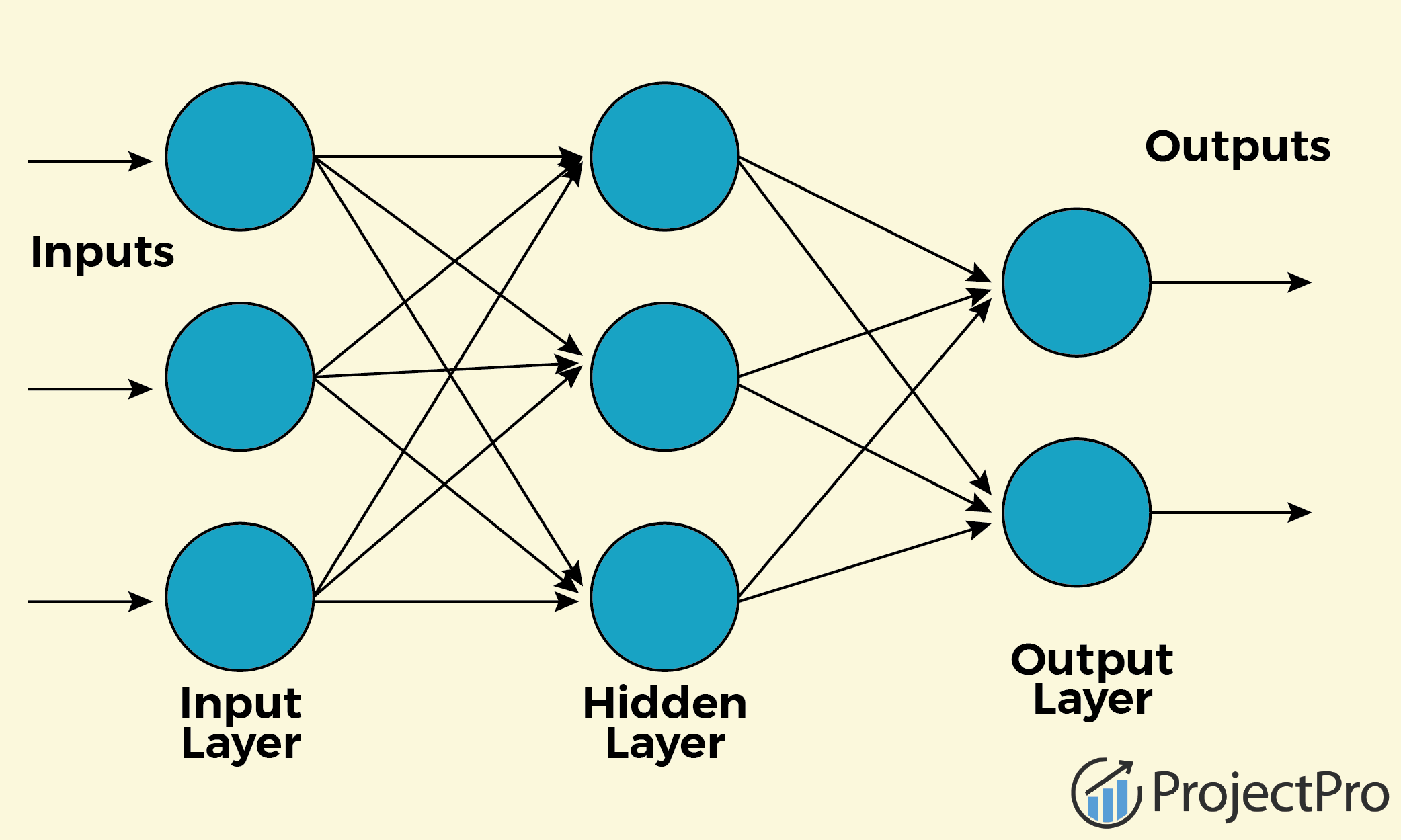
Perceptron is a binary classification algorithm that uses a linear learning approach. It is one of the earliest and most basic types of artificial neural networks. For two-class classification tasks, it can quickly learn a linear separation in feature space. Unlike the logistic regression model, it learns with the help of the stochastic gradient descent optimization process and does not predict calibrated probability.

Source: H2O.AI
We will use the H2O.ai library, which is an open-source platform for machine learning and predictive analytics. Its key purpose is to serve as a distributed, parallel, in-memory processing engine. It supports the simple horizontal scaling of an issue to get a quick solution. It supports data in various formats, including CSV, ORC, Parquet, and Hive. It allows data intake from various sources, including the local file system, remote file system, HDFS, and Hive. We start the H2O cluster, load the Census-Income dataset, and split it into features (X) and target (y). We then convert the target variable to a factor, as required by H2O.ai. Next, we split the data into training and testing sets using scikit-learn's train_test_split functions. After training, we make predictions on the test set using the trained model and convert the predicted labels to the original income categories ('>50K' and '<=50K'). Finally, we calculate the accuracy of the model.
In this data science project, once the data has been ingested and processed, we obtain the training and validation accuracy, showing that our data is not overfitting. Further, the data science project involves working with Area under curve (AUC) and Grid search techniques for hyperparameter tuning.
Income received routinely (excluding specific money receipts such as capital gains) before payments for personal taxes, welfare benefits, union dues, healthcare liabilities, and other deductions is regarded as Census money income.
Ordinary least squares regression, beta regression, robust regression, ridge regression, MARS, ANN, LSSVM, and CART are some of the benchmark regression methods for income prediction modeling.
The census income prediction project aims to predict whether an individual's income exceeds 50K yr based on demographic and socio-economic factors. This project uses machine learning algorithms trained on census data to develop an accurate income prediction model.
You can access data from the Census Bureau by visiting their website at census.gov. The website offers various tools and resources for accessing and analyzing census data, including the American FactFinder database and the Census Data API.
An example of census data is the United States Census, which collects demographic and socio-economic data from every household in the country every 10 years. This data includes population, housing, income, education, and more information.
Recommended
Projects
Adam Optimizer Simplified for Beginners in ML
Unlock the power of Adam Optimizer: from theory, tutorials, to navigating limitations.
8 Deep Learning Architectures Data Scientists Must Master
From artificial neural networks to transformers, explore 8 deep learning architectures every data scientist must know.
Microsoft Fabric - All-in-one AI-Powered Analytics Solution
Microsoft Fabric - The ultimate AI-driven analytics solution. From data integration to predictive modeling, revolutionize your decision-making process.|ProjectPro
Get a free demo






